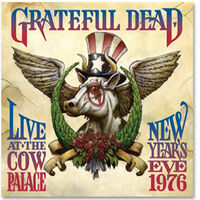
The album cover
Live At The Cow Palace is an album made by the Grateful Dead. The album was played at Cow Palace in 1976. Over 13,000 Deadheads were there. It started with "Promised Land" and ended with "We Bid You Goodnight."
About The Album[]
Grateful Dead On the Crest of a Wave
One of the many great pleasures of listening to so much Grateful Dead material is the variety of styles of music heard. Ev
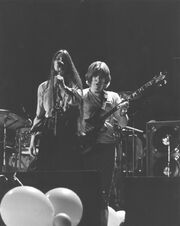
12-31-76
ery year, and in fact every tour, found the band challenging itself to find new creative destinations for their music. For virtually any Grateful Dead tour, a habitual listener can hear a few seconds and quite easily identify the year of the recording, or even the month in some cases. At any given show, one can identify touches of the many styles of Grateful Dead music played throughout their history--but rarely does any one show clearly display the essence of several distinct periods of their sound. New Year's Eve 1976-1977 is one of those shows that contains the best elements of three or four clearly defined eras, and the sum of the parts adds up to the one of the most interesting, and inspired, concerts of the band's 30-year performing career.
Opening with the rather frequent 1976 show opener "Promised Land" followed by "Bertha," the show begins as a quintessential 1976 performance: mostly confident, deliberate, yet slightly tentative. As the set gets rolling, the band begins to take more chances, heading toward the typically powerful 1976 second-set material. However, as the first set nears its close, we are treated to a version of "Playing In the Band" that is as large, long, and exploratory as any version from late 1974, the ne plus ultra period for this improvisational vehicle. A satisfying 1976 first set is elevated to the realm of 1974 flashback by this masterful performance.
The midnight festivities get off to a rousing start with the appropriate "Sugar Magnolia" opener, complete with countdown and balloons popping. What comes next is a sustained 40-minute run of music that ranks up there as one of the best-played jams of 1976. Starting out with the new, faster, more powerful version of "Eyes of the World," the jam then slips into a beautiful "Wharf Rat." Next up is only the third performance of "Good Lovin'" sung by Bobby Weir, and the short-but-intense instrumental bridge harkens back to the versions from 1972, while foreshadowing the power with which this song would develop later in 1977. As if this wasn't enough, Weir then drives the band through a reggae-tinged beat that magically morphed into one of the smoothest, funkiest versions of "Samson & Delilah" ever performed. Remember, this was a song that was played at all but two of the 41 shows performed in 1976, and despite the possibility of staleness due to overplaying, this version stands out as completely unique compared to the other 38 versions in 1976. Disc 2's finale, the mid-point of set two, then recalls 1974 again with a long-rollicking, and peak-
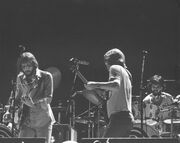
12-31-76
laden "Scarlet Begonias." Amazingly, though, the best was yet to come.
After a solid run of "Around and Around," "Help On the Way," and "Slipknot!" (minus the third part of the triumvirate, "Franklin's Tower"), the band then proceeds into a note-perfect "Not Fade Away," ending this massive second set with one of the longest and most emotionally draining versions of "Morning Dew" ever performed. This rendition is at the very top of many Deadheads' favorite "Dew" lists, up there with Cornell and 10/18/74. A three-song encore ends the night, capping one of the most intriguing evenings of Grateful Dead music, one that bridges the gap between the exploratory jazz of 1973-1974 and the orchestrated perfection of 1977. Remember, it was at the very next show that the band would debut "Estimated Prophet" and "Terrapin Station," about as far removed from 1974 as you could get. New Year's Eve 1976-1977 is a timeless night of music that reminds us all that there really is no easy way to categorize the Grateful Dead, and there certainly is nothing like a Grateful Dead concert.
-- David Lemieux
A Palace for Cows
Let's start our countdown to the New Year, 1977, just a little bit earlier: 1915.
Recoving from the 1906 earthquake and fire, San Francisco held an ambitious world's fair--one of the greatest ever--the Panama-Pacific International Exposition. Officially a celebration of the opening of the Panama Canal, it really celebrated the city's comeback. The fairgrounds stretched along the city's north shore, between Fort Mason and Fort Point. The only building that survives is the astounding Palace of Fine Arts, by the great Bernard Maybeck.
Maybeck designed other buildings for the Exposition--the Lumberman's Building, the House of Hoo Hoo (!), and one of the hottest attractions in that still-rural America, the Livestock Pavilion.
The Pavilion was so popular that the city resolved to build a permanent home for its exhibitions. That was in 1915. Plans were drawn and debated, bureaucracies created and dissolved. Calendar pages fluttered. Years went by, decades. The Depression came, the plans were shelved. At last, in the late 1930s, construction began on the California State Livestock Pavilion.
It didn't remotely resemble Maybeck's elegant creations. Instead, it was a vast, concrete, metal-roofed arena, a container for huge herds of people and other livestock. It was located not by the beautiful Bay, but on the border of San Francisco and the non-descipt town to the south, Daly City.
During construction the place was ridiculed by some wiseacre as "a palace for cows." In classic San Francisco contrarian tradition, the builders embraced the name. It was now, and would evermore be, the Cow Palace.
In 1941 the doors finally opened to honor bovine royalty at the Western Classic Holstein Show, quickly followed by the Grand National

12-31-76
Rodeo. Two weeks later Pearl Harbor was attacked. The newly opened Cow Palace was closed, then transformed into a staging area for American troops heading to the Pacific war.
After the war, the cattle, nags, and swine returned--along with other entertainers. The Cow Palace became San Francisco's biggest indoor venue, holding record crowds of up to 13,000 for basketball, hockey, boxing, wrestling, roller derby, the Billy (not Bill) Graham Crusade for Christ, and two Republican conventions. And--in spite of its miserable, echoey acousitcs--live music.
On August 19, 1964, two weeks after the Republicans nominated Barry Goldwater there, The Beatles, following a handful of one-off performances on the East Coast, played the debut show of their first official American tour at the Cow Palace. The lads came back a year later, playing the last one of their 1965 tour there on August 31. (They would play their final concert anywhere ever in San Francisco, too, in 1966 at Candlestick Park.*)
In the crowd at the 1965 show were those pioneering acidheads, Ken Kesey and the Merry Pranksters, tripping on LSD amid a sea of screaming Beatlemaniacs. As brilliantly described by Tom Wolfe in The Electric Kool-Aid Acid Test, the Pranksters had decided, with their acid-pretzel logic, that they and The Beatles were destined to meet. So before the show, they put up a sign at the entrance to their La Honda headquarters: THE MERRY PRANKSTERS WELCOME THE BEATLES. Somehow they knew they'd connect with The Beatles and persuade them to (literally) get on the bus.
Instead, the concert turned into a bad trip for Kesey, who, in the middle of The Beatles' 20-minute-long performace, ordered all the Pranksters out, over the protests of Mountain Girl and others. They escaped from the evil (to Kesey) shrieking and went home. The Beatles, of course, didn't show up. But, in a classic moment of psychedelic synchronicity, someone else was waiting for them instead: a strange, short stranger named Augustus Stanley Owsley III.
No Beatles, but the opening of a door that led directly to the Grateful Dead--who were then Th
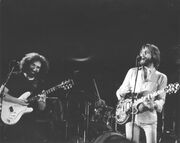
12-31-76
e Warlocks, playing their first pizza parlor and bar gigs around San Jose.
Owsley, aka Bear, had materialized straight from his secret L.A. lab, where he'd produced an enormous number of hits of then-legal LSD--by various estimates, anywhere from 100,000 to 10 million. He was ready to unleash them on the world, and he saw Kesey and the Pranksters as the ideal unleashers.
So Owsley joined the Prankster entourage as chief alchemist and electrical engineer. He supplied the Kool-Aid for the Acid Tests. The music was supplied by the newly renamed Grateful Dead.
Bear supported the Dead both financially and artistically. With Bob Thomas, he designed the skull-with-lightning-bolt logo (later known as "steal your face"). And he became the Dead's electronic wizard, sound engineer, and recordist.
By 1967 the Dead were becoming famous, the symbol of the Haight and the media-hyped Summer of Love. But Owsley was on his way to prison, caught with hundreds of thousands of now-illegal doses (which he had the chutzpah to claim were all for his personal use). By the time he saw the daylight, it was the 1970s. The band had evolved from their psy
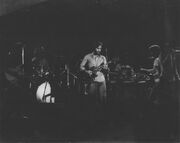
12-31-76
chedelic free-form origins to that indefinable genre that can only be called The Dead, with influences ranging from jug bands, to those same Beatles, to John Coltrane, to Charles Ives, to Spike Jones... Ah, just read the Oxford Dictionary Of Music, all of its thousands of pages, and make your own list.
They'd gone through their transformation into the brilliant songwriters of the Workingman's Dead/American Beauty era. They'd long ago expanded from their Bay Area base to the ever-growing Dead Head nation.
The size of the Dead's venues had steadily expanded too. By the early '70s they were generally playing to audiences numbering in the low thousands, mostly in theaters and at open-floor concert halls and outdoor venues. The biggest San Francisco venue they played regularly was Winterland, to an audience of 6,000 or so.
The bigger the venue, the more ponderous the music tends to get, as it resonates with the size of the space. The Dead, as we know, had the taste and skill to overcome the challenge; still, Winterland and other (for that era) huge spaces were not band favorites.
Which brings us back to the Cow Palace--the size of two Winterlands, and with acoustics bad enough that the cows themselves could have been excused for complaining. But on March 23, 1974, the Dead took on the venue with a mighty weapon on their side, in its world premiere: the Wall of Sound.
The Wall of Sound was the cocreation of Owsley, Alembic Inc., Bob Matthews, Betty Cantor, Dan Healy, and other mind-melders. A gigantic city of speakers, it towered above the band. It was quadraphonic, with huge clusters of satellite speakers at the back corners of the hall. The sound mixers could, and did, ping-pong sounds around the h
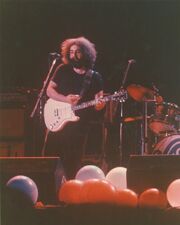
12-31-76
all, over the heads of the audience.
Despite a few glitches, the first Cow Palace show--and the Wall of Sound debut--was a triumphant success (as you can confirm for yourself; it's Dick's Picks #24). The sonic quality of the Wall of Sound was tremendous. Unfortunately, so was the expense of schlepping this monster on the road. By the end of 1974 the 70-ton Wall was weighing down the Dead both literally and figuratively. The financial burden of the extra crewmembers and semi trucks was crucial in the band's decision to quit touring that fall.
The run at Winterland that became The Grateful Dead Movie marked the end of the Wall of Sound era, after only 37 shows. The Dead went on hiatus--or, as they called it, "vacation." For over a year and a half, they stayed off the road, working in the studio, improvising and jamming on music that evolved into the masterpiece Blues For Allah, Mickey Hart, out of the band since 1971, rejoined for the sessions.
Through 1975 the reconstituted two-drummer Dead played just four shows, all in San Francisco. They featured the Blues For Allah work-in-progress at each of them, officially unveiling it at the third show, at the Great American Music Hall (immortalized as One From the Vault).
In the Dead Head newsletter of New Year's Day, 1976, the band announced their return. "Vacationing is too exhausting [to] continue, meaning the Grateful Dead has decided to return to touring."
This time, they went out leaner and lighter. The Wall of Sound was gone, replaced by a smaller sound system that was still light-years ahead of what other groups were using. They mostly played small theater venues, with larger shows mixed in toward the fall--including two huge ones, cobilled with The Who at Bill Graha
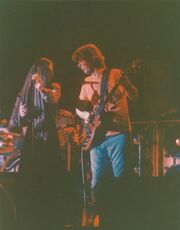
12-31-76
m's on the Green at the Oakland ballpark. And they decided to end the year by playing their first New Year's Eve show since 1972.
Which again brings us back to the Cow Palace...to December 31, 1976...and to this very recording. And now the writer will modestly inject himself into the story. My first Dead show: New York, May 4, 1968, Central Park mall, with Butterfield and the Airplane. Many many many many more followed.
For five years, until 1976, I was DJ/program director at a free-form hippie radio station in Pittsfield, Mass., playing the Dead every day. It fell apart, as radio stations will. That November I was back in San Francisco, where I'd lived before, in the home of the greatest radio station of them all, KSAN, Jive 95.
KSAN had been my role model for our station back East. It was radio Mecca. And incredibly enough, two days after getting to town, I was behind the KSAN mike. It seems the entire staff had to sit for a group picture... They needed a warm body... Mine was warm enough. I went in there a nobody, but I came out with a part-time job...and the title of resident Dead Head. A few weeks later I was asked if I'd like to cohost the New Year's Eve broadcast of the Dead at the Cow Palace. Yes.
So it came to pass that, with the legendary lovely Bonnie Simmons, I spent the last moments of 1976 on the stage of the Cow Palace, amid 13,000 loony, ecstatic Dead Heads.
Santana preceded the Dead, and they burned the house down for an hour. Then came that electric buzz of audience plus electronics that anticipated every Dead show. KSAN went on live, and we tried to capture in mere words the multisensory circus around us. You can't.
Somewhere pa

12-31-76
st 10, the Dead came on to play their premidnight first set. The usual tuning, then those Chuck Berry riffs, and they're off.
Garcia described the band as sometimes flying gracefully, sometimes lumbering along, wings flapping, laboring to take off. This is one of those nights when they're airborne from the start, and climbing fast, on a jet to the Promised Land.
From the beginning the moving parts are in synch, meshing with precision...Phil making the hall shake, Mickey and Billy making the asses shake, Bob and Keith chopping out rhythms and fills, Jerry tearing into leads, the vocals strong, Donna's harmonies blending sweetly.
The Dead made the huge, ungainly space of the Cow Palace sound beautiful and harmonious, playing brilliantly through the first set, raising the ante with an especially strong "Playing In the Band" to finish part one.
Midnight approached, and with it, the start of both the New Year and the Dead's second set. But at a Bill Graham New Year's show, midnight is when Bill says it's midnight. The time ticked by, the band trickled onstage, got ready, stood around...and then, just before midnight (Bill Graham time), the countdown began.
Attended by fully grown diapered New Year's babies, Father Time (who looked an awful lot like Bill) appeared out of a giant hourglass. A sign delaring "1977," in lights, descended from the heavens. Multitudes of multicolored balloons floated down, bouncing off the crowd and the stage as the Dead rolled into a sensational "Sugar Magnolia," the kickoff of two more hours of sublime sounds. I could describe them...but why describe when you can listen?
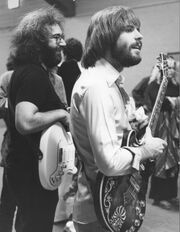
12-31-76
The second set rolled to a close around 2 a.m.--and then came the encores: "Saturday Night," "Uncle John's Band," and a final "We Bid You Goodnight," close to three hours into the new year. Whooooo! It's 1977!
From then through 1991, the Dead never again missed a New Year's Eve. I was at many other before and after (one of them was my wedding night!)--but this show stands out as one of the very best. It was the second, and last, show the Dead would ever play at the Cow Palace.
Leading into "Mama Tried," Bob says "God bless all you folks who had enough sense tonight to stay home and listen to the radio...And Lord have mercy on all us crazies down here." Same to you listening to these CDs--from one of us crazies.
--Glenn Lambert
- Unless you count the rooftop performance in Let It Be, which I don't. That gimmick, by the way, was a direct steal from the never-finished 1968 film by Jean-Luc Godard, One A.M. (One American Movie), in which he put Jefferson Airplane on a New York rooftop, where they played "House at Pooneil Corner" until the cops showed up, just like in Let It Be. (U2 later restole the same gimmick, complete with cops, for a music video.) The Airplane performance can be seen on their DVD compilation Fly Jefferson Airplane.
P.S.: If you older Deadheads can read this, you pass the eye test.
Track[]
Disc 1:
- Promised Land
- Bertha
- Mama Tried
- They Love Each Other
- Looks Like Rain
- Deal
- Playing In The Band
Disc 2:
- Sugar Magnolia->
- Eyes Of The World->
- Wharf Rat->
- Good Lovin'
- Samson And Delilah
- Scarlet Begonias
Disc 3:
- Around And Around
- Help On The Way->
- Slipknot!->
- Drums->
- Not Fade Away->
- Morning Dew
- One More Saturday Night
- Uncle John's Band->
- We Bid You Goodnight
Personnel[]
- Jerry Garcia – guitar, vocals
- Donna Godchaux – vocals
- Keith Godchaux – piano
- Mickey Hart – drums
- Bill Kreutzman – drums
- Phil Lesh – electric bass
- Bob Weir – guitar, vocals
Production
- Recorded live at the Cow Palace, Daly City, CA, December 31, 1976
- Recording - Bob Matthews, Betty Cantor-Jackson
- Mixing - Jeffrey Norman
- Assistant engineer, digital editing - Robert Gatley
- Original 16-track master speed and time base correction - Jamie Howarth at Plangent Processes
- Produced for release by - David Lemieux, James Austin
- Executive producer - Jimmy Edwards, Gregg Goldman, Peter McQuaid
- Cover art - Timothy Truman
- Art supervision - Scott Webber
- Booklet essays - Glenn Lambert
- Booklet introduction - David Lemieuxt
- Under disc photos - Ed Perlstein
- Booklet photos - Ed Perlstein, Steve Schneider
- Additional booklet photo courtesy of Cow Palace
- Package design, cover typography - Steve Vance
- Editorial supervision - Dorothy Stefanski
- Project assistance - Reggie Collins, Karen LeBlanc, James O'Toole
- Special thanks - Brian Connors, Arnie Grager, Mary, Rocky & Randal at the Plant Studios, Sausalito